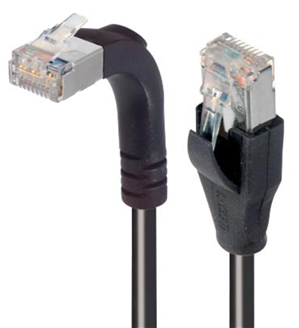 Wired connectivity offers significant advantages that make it an ideal choice for many applications that require reliable and secure connections.
Wired connectivity offers significant advantages that make it an ideal choice for many applications that require reliable and secure connections.
Introduction
All advanced electronic systems need reliable connections. Good network connectivity reduces the possibility of disruptions, enables seamless transfer of data and power, and minimizes signal losses. Network connections are of two primary types: wired and wireless. A wide range of applications (e.g., building automation and process instrumentation) continue to rely on wired connectivity, eschewing the convenience of wireless connections. This article explores both wired and wireless connectivity, taking a deeper dive into the many benefits of wired connections. It will also spotlight popular L-com products to help readers choose the best solution.
What is Wired Connectivity?
Devices having wired connectivity use physical cables (example: co-axial cables, twisted pair cables) and wires (example: fiber optics) to transmit data and power between them. Some popular examples of wired connectivity include cable TVs, landline telephone networks, communication between field devices and controllers, etc. Since users have high bandwidth, the exchange of information through wired connections are invariably robust and secure.
Figure 1: TRD695BL-10 - Ethernet Cable, Cat6, RJ45 Plug to RJ45 Plug, UTP (Unshielded Twisted Pair), Blue, 3 m, 10 ft
What are the Advantages of Wired Connectivity?
Wired connectivity offers several advantages that makes it an ideal choice for many applications that require reliable and secure connections.
- High reliability and stability:Wired connectivity, if configured properly, makes a highly reliable and stable communication medium. Here, signals are not affected by other network connections or nearby objects or physical obstacles.
- High speed: Wired connections offer faster data transfer speeds and are usually not overburdened by unexpected traffic. Here, separate cables, particularly Ethernet or fiber optics, are used to connect the different devices to the network, so there are no connectivity issues such as dropped connections, etc.
- Network Visibility: Wired networks are not visible to devices on other networks, making it impossible for users outside the network to connect directly to the network. Simultaneously, it also allows security mechanisms to identify illegal access to the network, enabling them to react promptly.
- Security:A wired network outfitted with appropriate firewalls and other security features, such as intrusion detection systems, shields the network from unauthorised access and attacks. Since a physical connection is required in a wired network, it is more difficult for an attacker to gain access to a network and obstruct sensitive data.

Figure 2: TRD695SZRA2BLK-2 - Ethernet Cable, Cat6, 90° RJ45 Plug to RJ45 Plug, FTP (Foiled Twisted Pair), Black, 609.6 mm
What are the Disadvantages of Wired Connectivity?
While wired connectivity offers multiple benefits, it also presents a few challenges that may impact its suitability for some environments:
- Lack of Mobility: Wired networks are highly inflexible when it comes to mobility. This may be inconvenient depending on how much mobility a business or process demands.
- Installation: A wired network requires installation of hubs, routers, switches, and lengthy wires to connect different devices. This installation process can be complex and time consuming, depending upon the size of the network infrastructure. It also requires configuration of firewalls and other security applications.
- High maintenance: Setting up a small, wired network may be easy as it requires fewer components and labor. However, expanding an existing wired network requires the installation of servers to manage the bandwidth and network load. Extensive networking cabling cable can contribute to an increase in maintenance and labor costs.
Taking a Look at Wireless Connectivity
Wireless connectivity uses high-frequency radio waves to transmit signals instead of wires. There are different types of wireless connectivity, such as Wi-Fi or wireless Fidelity, Bluetooth, Near Field Communication (NFC), Zigbee, LoRa, LTE, etc., each with unique features. Wireless networks are very common in homes and offices, as well as in industrial environments for remote monitoring and asset management. Wireless connectivity is also used in process control, such as NFC Sensor Tag solutions to collect temperature, humidity, and pressure motion sensor data, or in industrial automation applications, such as Automated Guided Vehicles (AGVs) or Autonomous Mobile Robots (AMRs). Wireless networks are also popular in warehouse and logistic operations for real-time distribution, inventory management, etc.
Figure 3: TRD695WP-2M - PATCH CORD, RJ45 JACK-JACK, CAT6, 6.6FT
What are the Advantages of Wireless Connectivity?
Wireless connectivity provides multiple options that makes it a viable option for a variety of applications and environments:
- High mobility: Wireless networks allow users to be more mobile, making them more flexible in accessing the network from various locations within the device range.
- Cost: Implementing a wireless infrastructure is less costly than a wired network, as the hardware is less costly, and there are considerable savings in cabling costs.
- Easy installation and maintenance: Wireless networks are easy to install and maintain as they require less equipment, thereby saving a considerable amount of time for installation. They do not require cabling installation or replacement to the extent a wired network would, which also saves a lot of wiring and labor costs.
What are the Disadvantages of Wireless Connectivity?
Although wireless connectivity provides convenience and flexibility, it has limited capabilities that would prevent it from being the ideal choice for some applications and environments:
- Reliability and Stability: Wireless connections are susceptible to interference from electromagnetic interference (EMI), other electronic devices, and physical obstructions such as a building’s walls or structures. They can have a higher latency count, which in turn can affect the performance of some real-time applications.
- Security concerns: Wireless connections are vulnerable to unauthorized access and data can be intercepted by hackers. However, implementing security measures such as firewalls and regular passwords changes can increase a wireless network’s security.
Figure 4: TRD855SCR-10 - Ethernet Cable, Cat5e, RJ45 Plug to RJ45 Plug, Grey, 3 m, 10 ft
Comparing a Wired and Wireless Network Connectivity Design
The following table shows a brief comparison between wireless and wired connectivity. Weighing these elements will help users make an informed decision about selecting the right connectivity for their applications.
| Features | Wired connectivity | Wireless connectivity |
| Mobility | Low, devices need to be connected to the wired network. | High, devices can be connected wirelessly within the network range |
| Installation | Complex process as it requires installation of cables | Much simpler process since there is no need for cabling |
| Speed | Generally faster, offers higher data transfer speed. | Generally slower compared to wired. |
| Security | Highly secure. It requires physical access to enter into the network | Less secure. Vulnerable to hacking and unauthorized access |
| Latency | Low latency, suitable for real-time applications | Comparatively high, improving the real time application’s performance |
| Reliability | High reliability and less susceptible to interferences | Lower reliability and experiences interference from other wireless signals present in the vicinity. |
| Maintenance | High maintenance cost and labor-intensive process, and difficult to expand | Low maintenance cost and expansion is also easy |
What is the Deciding Factor between Wireless and Wired Connectivity?
With the growth of mobile and Internet of Technology (IoT) devices, wireless connectivity has rapidly increased due to its easy accessibility and convenience. However, there are critical applications where wired connectivity would be the preferred option. For example, in industrial automation environments, there is a requirement for reliable connectivity of sensors, actuators with controllers, and high-level communication to or from a cloud platform. Wired connection provides secure, robust, and reliable communication for time-critical functions inside the factory environment for motion control applications such as printing, milling, and multi-axis computer numerical control (CNC) machines used for motion control that require communication task controls with cycle times less than 1 millisecond, with sub-1-microseconds jitter.
Another example of a preference for wired connectivity would be the healthcare industry. In robotic surgeries a stable connection is a must. The surgeon remotely monitors the robot and the associated devices used in the surgical process. Such a procedure needs a stable connection. A drop in connection or significant latency can be catastrophic. Another healthcare example is medical imaging applications such as MRIs and X-ray machines. They require considerable bandwidth as images are produced and then transferred through the hospital network. Wired connectivity is often the preferred means of network connectivity in healthcare infrastructure.
Conclusion: When Should You Go Wired?
The right selection of a suitable wireless or wired connectivity is associated with the requirements of a particular application and performance factors such as cost, security, scalability, bandwidth, flexibility, etc. This article provided an overview of the requirements, benefits, and drawbacks of wired and wireless connectivity for optimal performance of process and infrastructure. L-com offers a wide portfolio of products associated with wired connectivity, which helps drive reliable networks.
For more types of wired connectors and cable assemblies from L-Com Shop Now
About the Sponsor
![]()
L-com, a leading manufacturer of wired and wireless connectivity products, offers a wide range of solutions and unrivaled customer service for the electronics and data communications industries. The company’s product portfolio includes cable assemblies, connectors, adapters, antennas, enclosures, surge protectors and more. Headquartered in North Andover, Mass., L-com is ISO 9001:2015-certified and many of its products are UL® recognized. L-com is an Infinite Electronics brand.

